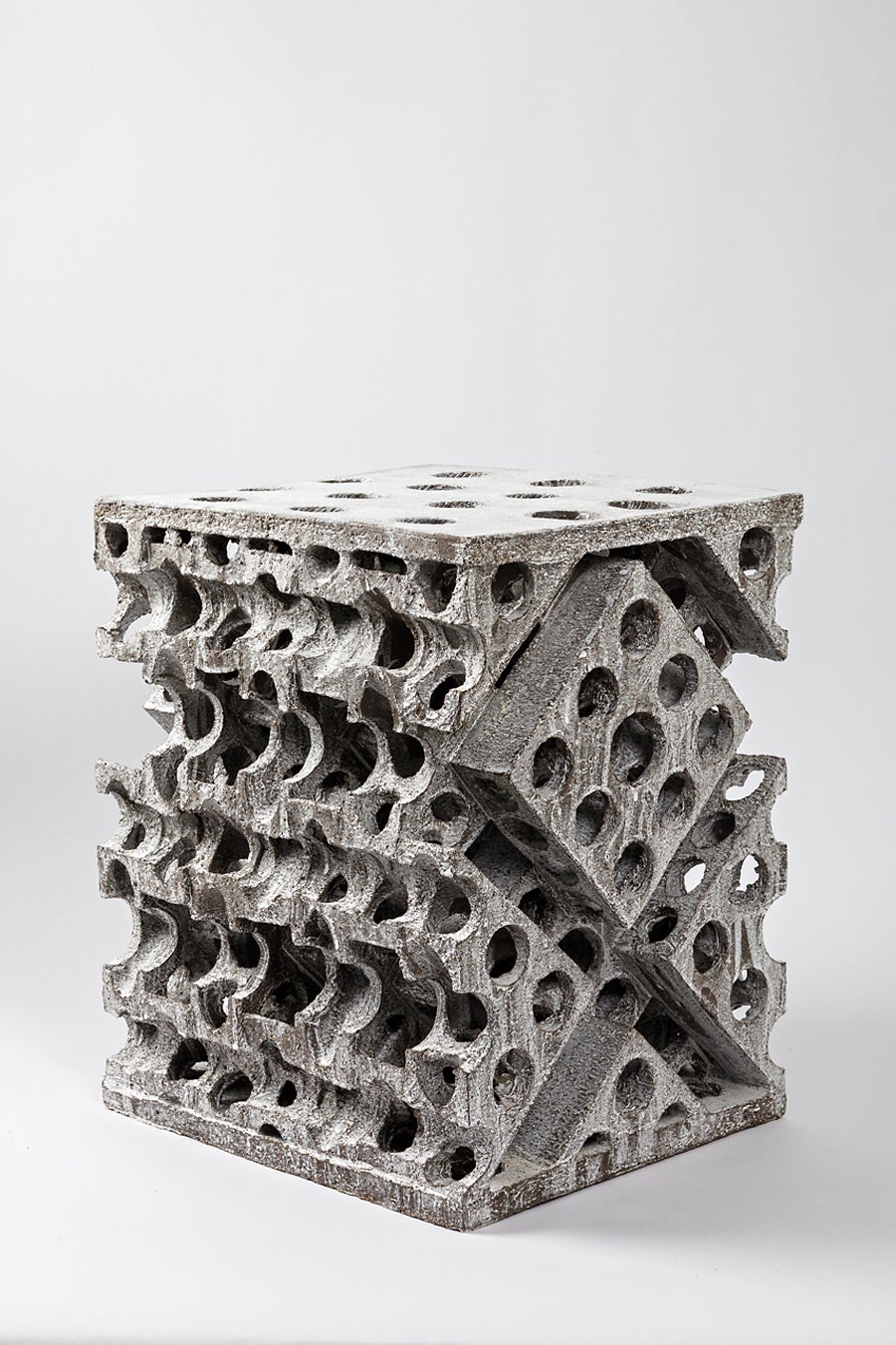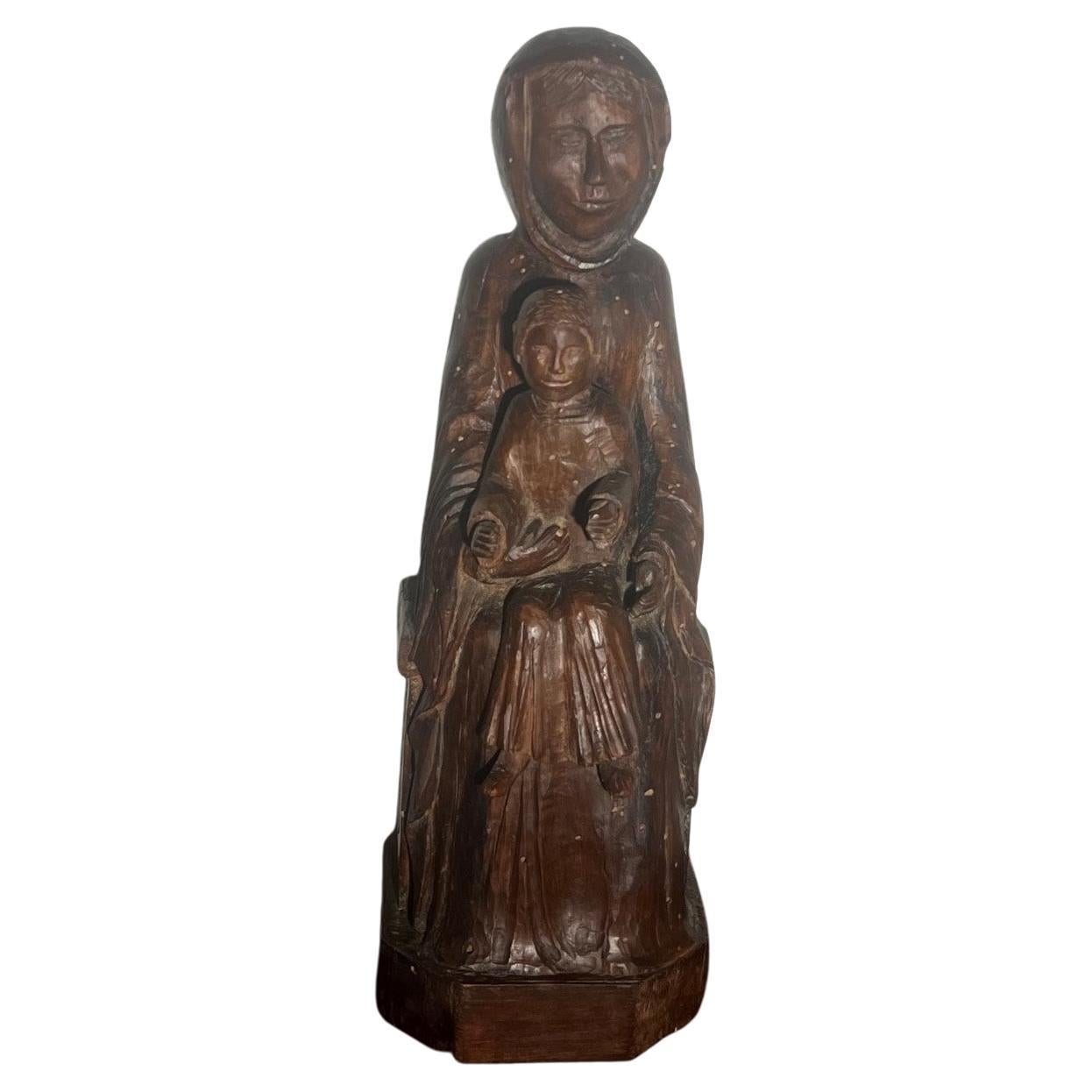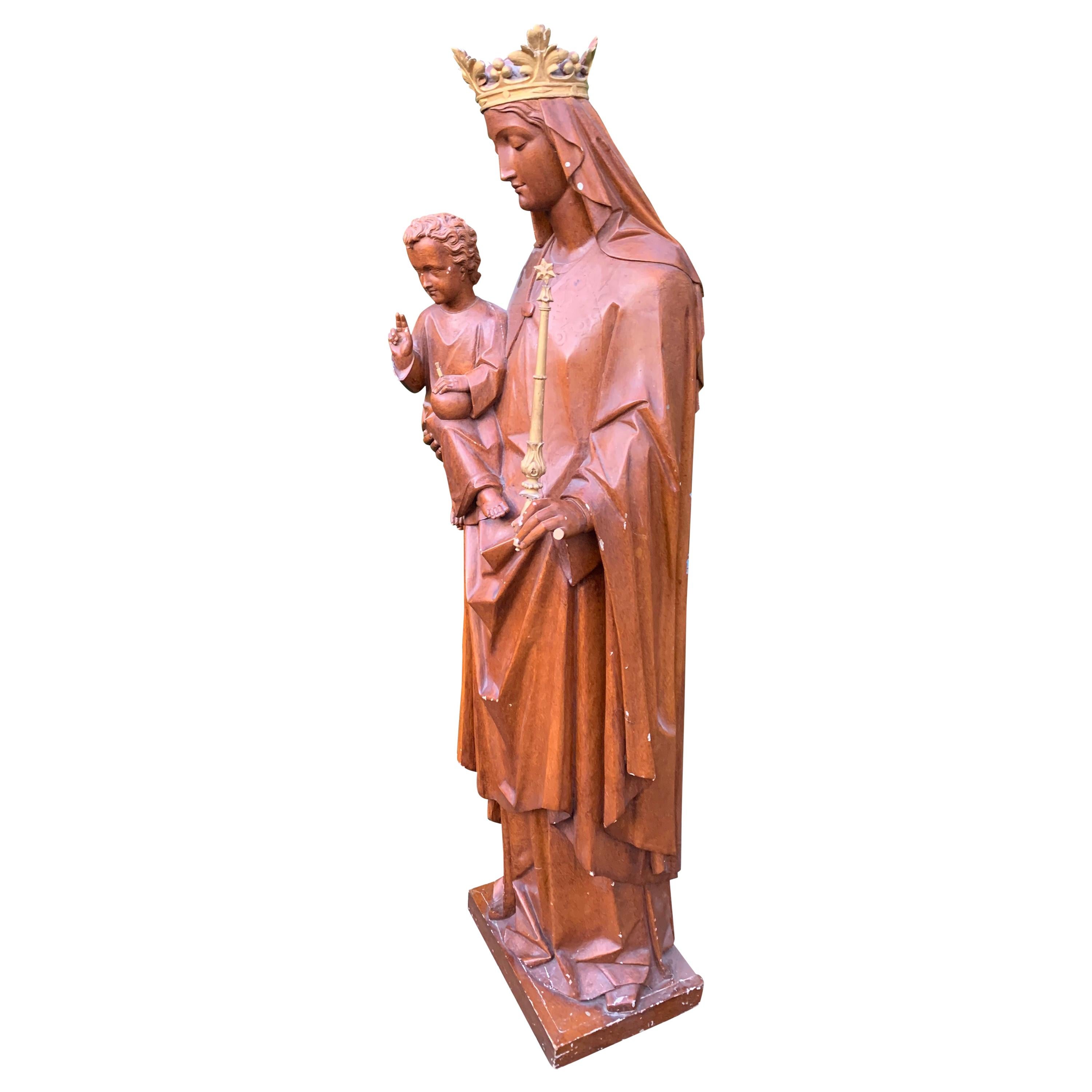Items Similar to Gothic Virgin and Child from Flanders
Want more images or videos?
Request additional images or videos from the seller
1 of 6
Gothic Virgin and Child from Flanders
About the Item
Exhibition
Museum Cantini, 1952, The art of the Middle Ages in the Marseille collections, n°101
Provenance
Former collection Louis Bresset (before 1952)
Former collection Professor de Vernejoul from 1952
This large sculpture of The Virgin and child can be assimilated to the works of art executed in Flanders in the 15th century. Art production was flourishing in Flanders at that time, yet this work is not without influence from French art.
This French influence can be recognised in the slight arch in the Virgin’s posture and the way she carries the child, dressed in a long tunic, with both hands.
The delicately gathered dress appearing under the heavy cloak shows workmanship of fine quality, realised by a great master.
The two sides of the cloak wrap the arms of The Virgin which hold her child. The cloak is livened up with deep and angular folds which spread from two points.
The folds on her left arm spread out like rays from a pinch in the fabric, a characteristic of Flemish workshops.
On her right arm however, the long fluted folds fall naturally onto the floor.
The structure of the face suggests that this sculpture would have come from Brabant, (The Brabant region and the Mosane region are also part of Flanders). This facial structure consists of a high and rounded forehead, a straight, slightly turned up nose and a small mouth, the corners of which are turned up revealing a slight smile. Finally the long wavy locks of the Virgin, covering her shoulders, are particularly well executed.
- Dimensions:Height: 38.59 in (98 cm)Width: 12.21 in (31 cm)Depth: 8.27 in (21 cm)
- Style:Gothic (Of the Period)
- Materials and Techniques:
- Place of Origin:
- Period:
- Date of Manufacture:15th Century
- Condition:Wear consistent with age and use.
- Seller Location:Saint-Ouen, FR
- Reference Number:1stDibs: LU3115327311722

About the Seller
5.0
Vetted Seller
These experienced sellers undergo a comprehensive evaluation by our team of in-house experts.
Established in 2016
1stDibs seller since 2017
147 sales on 1stDibs
Typical response time: 8 hours
- ShippingRetrieving quote...Ships From: Saint-Ouen, France
- Return PolicyThis item cannot be returned.
More From This SellerView All
- Gothic Virgin and Child with a PhylacteryLocated in Saint-Ouen, FRThis Virgin and Child is wearing clothes with a limited number of folds and showing a thickness characteristic of the Burgundy region. As a result of the presence in the region of th...Category
Antique 15th Century and Earlier French Gothic Figurative Sculptures
MaterialsWalnut
- 13th Century Virgin and Child from CataloniaLocated in Saint-Ouen, FRSeating on a bench-like throne the Virgin carries her child on her left knee. She bears an important crown high on her head .The Virgin has an ovoid face with bulging eyes, straight long nose and thin lips. The hair parts in the middle and are carved as thick horizontals parallel hair strands...Category
Antique 15th Century and Earlier Spanish Gothic Figurative Sculptures
MaterialsOak
- Polychrome carved wood Virgin and Child from the 15th CenturyLocated in Saint-Ouen, FRPOLYCHROME CARVED WOOD VIRGIN AND CHILD FROM THE 15TH CENTURY ORIGIN: SOUTH GERMANY, SWABIA, NUREMBERG REGION PERIOD: 15th CENTURY Height: 94,6cm Width : 28 cm Depth : 18 cm Lime wood Original Polychromy Good state of conservation From 1430 onwards, sculpture underwent a profound stylistic renewal which continued until 1530, the so-called late Gothic period. In the Germanic countries, original sculptures flourished in an expressive and sensitive vein. This renewal was inspired by the art of Nicholas of Leiden, who was active in Strasbourg in the 1460's. His style broke with the refined and delicate art of the international Gothic style in force throughout Europe around 1400. The figures became more authentic and realistic. The bodies became denser. Clothes are animated by deep, broken folds, the fabrics are heavy and have a great decorative value. In addition, the polychromy is intended to be illusionistic. The painting makes it possible to restore the texture of the materials, the richness of the textiles and the natural skin tone of the characters. The dissemination of images through engraving and the great mobility of the artists led to the success of this style, which conquered the Upper Rhine, Swabian, Tyrolean and Franconian regions, contributing to the formation of a common stylistic identity in these regions. The economic boom in the flourishing German cities was conducive to the development of original production. Attracted by this prosperity, numerous workshops were set up in order to meet the orders of religious communities, the Church and the laity, including a clientele of middle-class rockers. This precious Virgin and Child is depicted standing on a crescent moon, her head encircled by a crown of tall flowers. Her long wavy hair spreads over her shoulders, framing her beautiful oval face. Under fine eyebrows drawn with a brushstroke, her almond-shaped, slightly drooping eyes look at the Child with infinite softness. She is dressed in a long red dress with a rounded neckline, belted under the chest. The heavy fabric of her dress spreads out in broken folds at her feet. On her shoulders she wears a golden cloak. The drapery has deep folds. She holds out her right hand while she holds the Christ Child with her left. Christ, with his well-defined hair, is naked. His cheeks are highlighted with red, he holds an apple in his left hand and with the other hand makes a sign of blessing towards the faithful. Virgins with Child on a crescent moon were very popular in the second half of the 15th century, especially as the central subject of altarpieces in southern Germany and Austria. The crescent moon on which Mary is standing is reminiscent of the Woman of the Apocalypse. Often equated with the Virgin Mary. This episode is taken from the Book of Revelation (12:1-6) 1 Then a great sign appeared in heaven: a woman clothed with the sun, with the moon under her feet and a crown of twelve stars on her head. ; 2 She was pregnant, and she cried out because she was in labor, in pain from giving birth. ; 3 Then another sign appeared in heaven: it was a great fiery red dragon, with seven heads and ten horns, and seven royal crowns on his heads. ; 4 His tail swept down a third of heaven's stars and threw them to the earth. The dragon stood in front of the woman who was about to give birth so that when she gave birth, he might devour her child. ; 5 She gave birth to a son, a male child who is to rule all the nations with an iron rod. Her child was snatched up to God and his throne. ; 6 Then the woman fled into the desert, where God has prepared a place for her. There she will be taken care of for one thousand two hundred sixty days. Some theologians see in this woman a reference to the Virgin Mary and in the child, Jesus. This remarkable work is a very fine example of sculpture from Swabian workshops in the last decades of the 15th century. It presents all the characteristic stylistic elements: a highly girdled silhouette, an abundant drapery with angular folds, but also a great physical presence accentuated by the polychromy that restores the anatomical details. This group is made of a wooden log. The deep folds of the drapery highlight the movement of the Virgin holding the child. Bibliography : Sophie Guillot de Suduiraut, Dévotion et Séduction, Sculptures souabes des musées de France, vers 1460-1530, Paris musée du Louvre-Éditions somogy, 2015 “Revelation 12 - Common English Bible...Category
Antique 15th Century and Earlier German Gothic Figurative Sculptures
MaterialsWood
- Virgin and Child in Majesty, also known as "Sedes Sapientae"Located in Saint-Ouen, FRVIRGIN AND CHILD IN MAJESTY, ALSO KNOWN AS "SEDES SAPIENTIAE" ORIGIN : SPAIN, CATALOGNE PERIOD: EARLY 13th CENTURY Height : 95 cm Width : 32 cm Depth : 28 cm Softwood No polychromy In the middle of the 12th century, the Virgin took her place in churches, seated in Majesty, serving as a throne for her son Jesus. She is then called Sedes Sapientiae, meaning the Throne of Wisdom. At that time, she is not represented for herself and only exists because she has been designated as Theotokos, the mother of God, at the Council of Ephesus in 431, where the divine nature of Christ was proclaimed from his birth. The upright and perfectly hieratic bust of this Virgin and Child in Majesty is seated on a throne-bench. She is dressed in a tunic with a rounded neckline and covered with a fine mantle placed on her narrow shoulders. The supple and natural drapery follows the lines of the body. Large curls frame her face with delicate and regular features, a long straight nose, almond-shaped eyes, and small lips. She supports the Infant Jesus with her left hand. Like his mother, he is dressed in a long tunic, and his little feet are visible in the folds. He holds a small sphere in his left hand, while with his right hand, he gestures in blessing. The face of Christ bears a strong resemblance to his mother’s one, and he gives a slight smile. The position of the Child is no longer as hieratic, nor frontal or central as in the early 12th century, but his face still turns towards the faithful. The 13th century indeed emerges as a period of transition in the artistic domain. The statuary, while retaining certain characteristics still belonging to the habits of the previous century, also develops new formal solutions. As a result, Mary maintains a hieratic and frontal position, while her son shifts to place himself well to the left on her knee. Similarly, while the Virgin seems perfectly still, Jesus, on the other hand, appears much more animated, especially in the positioning of his hands. His left hand holds the orb, and judging by the raised right arm directed towards the faithful, one can easily imagine that he was making a gesture of blessing. The influence of the Sedes Sapientiae from previous centuries still seems particularly prevalent in this work. These few characteristics allow dating this Spanish Virgin...Category
Antique 15th Century and Earlier Spanish Gothic Figurative Sculptures
MaterialsSoftwood
- Virgin and Child in MajestyLocated in Saint-Ouen, FRVirgin and child in majesty Origine: castille Epoque: early 14th century Measures: Height: 72cm Length: 30cm Depth: 25cm Polychrome and gi...Category
Antique 15th Century and Earlier Figurative Sculptures
MaterialsWood
- Important 14th Century Polychrome Limestone Virgin from LorraineLocated in Saint-Ouen, FRProvenance : - Kunsthaus Heinrich Hahn, Frankfurt am Main, sale 16, June 17, 1930, lot 16. - Sotheby's, Amsterdam, Feb. 26, 2006, lot 201. HISTORIC Located between Moselle valley and Meuse valley, framed by the Vosges Mountains on the south side and the duchy of Luxembourg on the north side, the duchy of Lorraine is the result of several partitions. It starts with the 9th century when the Carolingian empire is divided, with Lothar 1st inheriting Lotharingia. In 959 this territory was in turn divided in two; Lower and Upper Lotharingia, the latter being the forebear of the duchy of Lorraine. This duchy was under the rule of the Holy Roman Germanic Empire until 1736 when it was absorbed by the kingdom of France. All along its history the duchy of Lorraine has found itself in the midst of many conflicts. Alliances and feuds marking European history were always particularly sensible in Lorraine where instability was frequent. Because of its geographic position the duchy of Lorraine was also an artistic crossroad. Hence the duchy of Lorraine becomes from the 13th century onwards an important artistic centre where a particular type of Virgin and Child appears. According to professor J. A. Schmoll the characteristics of Lorraine sculpture burgeon around 1280-1300 in the Aube region. It presents “vigorous volumes, restrained movements, rare but solemn gestures and a strong interiorised and stern expression”. Those Virgins look similar with a wide forehead, a shield- or oval-shaped face, large neck, small lips and a cleft chin. This model is particularly in favour during the 13th century because of the revival for Marial worship and for the theme of the Virgin and Child. It bears witness to a new religious sensibility with a more intimate vision of religious practice. DESCRIPTION The important 14th century Virgin we present to you is one of the most beautiful examples of sculptural art from Eastern France, with her fascinating distant gaze. Her contrapposto posture is induced by the weight of the child she carries high on her left side. The child has a chubby face framed by blond hair with well defined curls and he wears a long red V-collared tunic from which emerge his feet. The fabric is animated by long folds. The position of the right foot turned to the back is a detail we can notice on several Virgins from Lorraine. He holds a bird that seems to be pecking his thumb. “The bird /held by the child in his hands/ has been read as a reference to an episode from Christ’s childhood when he has moulded sparrows with clay before giving them life. It appears in the apocryphal gospel of Pseudo-Matthew (ch. 27) and later in the Quran (III, 43, v. 110). However the iconography seems to be more influenced by the concept of Redemption or of Eucharist, the bird symbolising the soul of the Christian about to be redeemed or revitalised.” Mary wears a long dress with two rock crystal cabochons remaining from the original five. She is covered by a red cloak enriched with old-gold motifs draped as an apron falling in long pleats along her left hip. The relief treatment and the volume of the cloak developing a network of concentric pleats contrast with the the flat pleating of her dress. They nevertheless suggest the curve of her bent right leg. She wears a floret crown securing a short thin veil carved in very low relief. From it emerges her blond curled hair characteristic of the 13th century. The large face with almond-shaped eyes, straight nose, small lips and cleft chin casts its gaze afar in a fashion typical of 13th century Virgins. In her right hand she holds a lily flower. In a very refined manner the artist has carved a band on her right ring-finger. In the back, carefully sculpted, spreads the minutely detailed short veil. COMPARATIVE STUDIES This sculpture of great quality presents obvious similarities with Virgins from Lorraine, designated by William Forsythe...Category
Antique 15th Century and Earlier French Gothic Figurative Sculptures
MaterialsLimestone
You May Also Like
- Antique Enthroned Virgin Mary and ChildLocated in Doha, QAThis extraordinary museum piece Enthroned Virgin Mary with the child on her lap comes from the Rhone region in France. The saint symbol and protector ...Category
Antique 15th Century and Earlier French Gothic Figurative Sculptures
MaterialsWood, Walnut
- Antique Lifesize Crowned Mother Mary and Child Jesus Gothic Revival SculptureLocated in Lisse, NLHand carved wood antique statue of Mother Mary wearing a Gothic crown. This original and all hand carved sculpture of the mother of all mothers is anothe...Category
Early 20th Century European Gothic Figurative Sculptures
MaterialsWood
- 19th Century Italian Alabaster Gothic Revival Virgin and ChildLocated in Marbella, ES19th century Italian alabaster Gothic revival virgin and child.Category
Antique Late 19th Century Italian Figurative Sculptures
MaterialsAlabaster
- Gothic Carved Oak Statue – Virgin of the AnnunciationLocated in Maidstone, GB15th Century Oak Wood Sculpture of the Virgin of the Annunciation beside a lectern supporting an opened book, the Virgin with both hands upraised ( one repaired) turning slightly to the left, her demeanour redolent of strength, compassion and benignity. Franco Flemish origin, circa 1480, 56 inches in height x 26 inches wide. Provenance : Lot 347, The Notable Art Collection, New York, April 1949, Joseph Brummer Collection Part 1Category
Antique 15th Century and Earlier Belgian Gothic Figurative Sculptures
MaterialsOak
- 15th Century Spanish Gothic Virgin and Child Polychrome Wooden SculptureLocated in Marbella, ES15th century Spanish Gothic Virgin and child polychrome figurative wooden sculpture.Category
Antique 15th Century and Earlier Religious Items
MaterialsWood
- Georges Jouve Virgin and Child, 1944By Georges JouveLocated in Saint Ouen, FRGeorges Jouve Virgin and child Black glazed ceramic with iridescent metallic luster Bears the signature on the back as well as the alpha symbol, c...Category
Vintage 1940s French Figurative Sculptures
MaterialsCeramic





